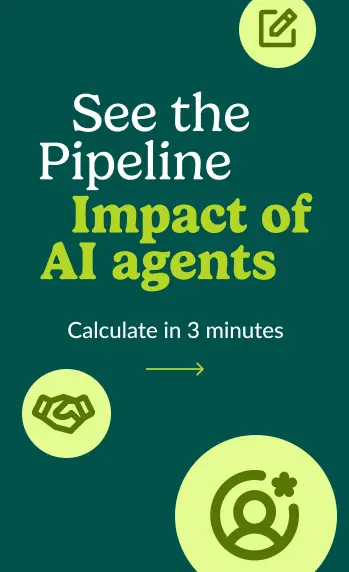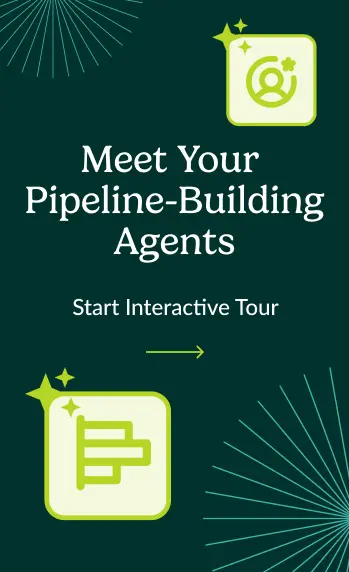A Practical Guide for Sales Leaders
Published:

AI isn’t optional anymore.
By 2027, Gartner predicts that 95% of seller research workflows will begin with AI. That means soon, AI will be a requirement, not a differentiator. The companies that lead won’t still be experimenting with sales AI in 2027. They’ll already be driving results and scaling. There’s still an opportunity to gain a first-mover advantage, but the window is closing.
And most organizations aren’t ready.
CROs are in a tight spot. Customer acquisition costs have doubled, and growth has stalled. You need to move at lightning speed, but the money’s not there to grow your team. Now more than ever, you need every member of your organization to achieve peak efficiency and work together as a well-oiled machine — but disconnected workflows, bloated tech stacks, and data silos are slowing you down.
And while organizations like yours are increasingly investing in AI, the payoff isn’t what you’d hope. McKinsey reports that over 80% of organizations have not seen a tangible impact on enterprise-level earnings from using generative AI.
Agentic AI is changing that story.
AI agents aren’t just automation or generation tools. They’re an operational layer designed to think and work like your best seller: embedded in the tools sellers use, trained on real buyer behavior, and focused on outcomes leadership cares about.
This guide is your blueprint for making that shift.
We’ll break down:
- What agentic AI actually means
- Where it fits into your revenue engine
- The use cases driving the biggest gains
- Why platforms outperform point tools
- And what it takes to scale AI with trust and impact
What is agentic AI?
Most sales leaders agree that AI has promise. Our research shows that 80% of revenue leaders believe automation will free up sellers to focus on higher-value activities. But only a tenth of those can explain what an AI agent actually does inside a sales workflow.
Here’s the simplest way to understand it: an AI agent is an intelligent program that can autonomously complete tasks on behalf of a user or another system. It responds to data, behavior, and context in real time, guiding sellers, managers, and leaders toward outcomes that contribute to revenue.
At Salesloft, we believe that for AI agents to unlock true value, three things need to be true:
- It’s embedded in the workflow
AI agents enhance workflows without making users open a new tab or change their process. AI agents show up right when they’re needed, bringing relevant data from across your tech stack to answer users’ questions and improve their processes.
- It’s explainable
Agentic systems aren’t just mindless automations. They’re intelligent systems tied to value and outcomes, taking over tasks a human isn't the best fit for while augmenting and advising users. As they work, they show their reasoning, giving sellers clarity, managers visibility, and leadership confidence in how decisions are made.
- It’s aligned to behavior
Agents are not generic, all-purpose tools like text generators or automation flows. An AI agent is purpose-built for the specific job the user needs to get done, and can do the work on its own.
Think of good agentic AI like electricity. You don’t notice it when it’s working, but everything stops when it’s gone.
This layered structure is what turns individual AI tools into a coordinated engine that adds to the bottom line.
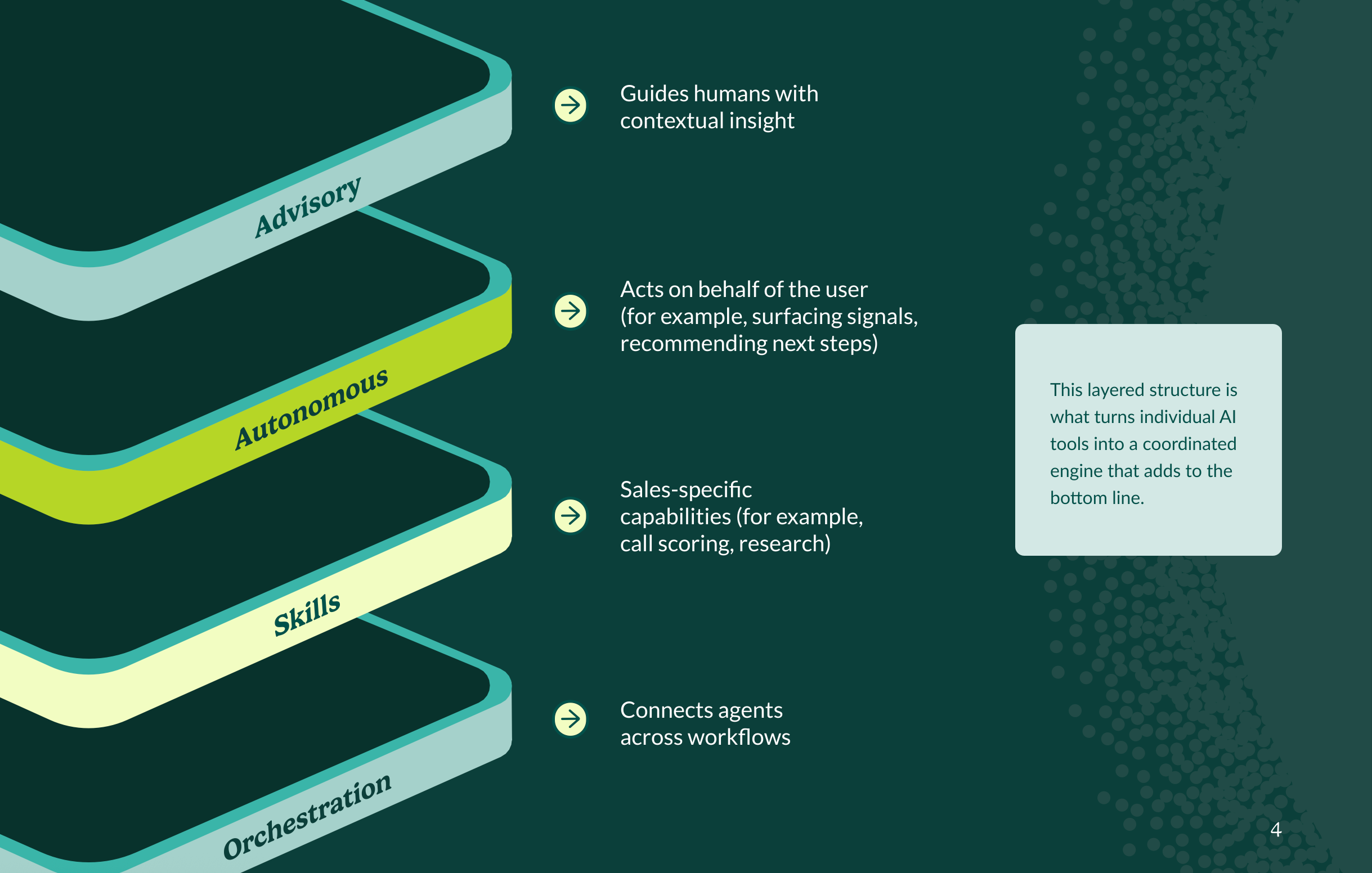
Human or agent? How to decide who’s doing the work.
While there’s a bunch of buzz around AI and AI agents, as a revenue leader, your reputation is on the line when it comes to how you deploy them. The wrong choice could lead to poor buyer experience, introducing risk, or disruption to your sellers’ workflows, leading to lost deals and revenue. Revenue leaders need to think strategically about where AI agents fit.
At Salesloft, we always ask three fundamental questions: ‘What is uniquely human?’ ‘What can be automated?’ ‘What can be augmented with AI?
Think through three lenses instead of focusing on features:
Uniquely human
Interactions that call for empathy, persuasion, or complex judgment
- Enterprise negotiation
- C‑suite relationship building
Augmented
Tasks that benefit from an AI agent’s ability to handle data‑heavy prep and a person’s understanding of nuance
- Personalized emails
- Call scoring and coaching
- Assessing deal risk
Automated
Repetitive, data‑rich, predictable, repeatable processes that an agent can own end‑to‑end
- Prospect research
- Meeting summaries
- Call scoring stalled‑deal flags
3 quick questions to ask yourself before assigning humans or agents
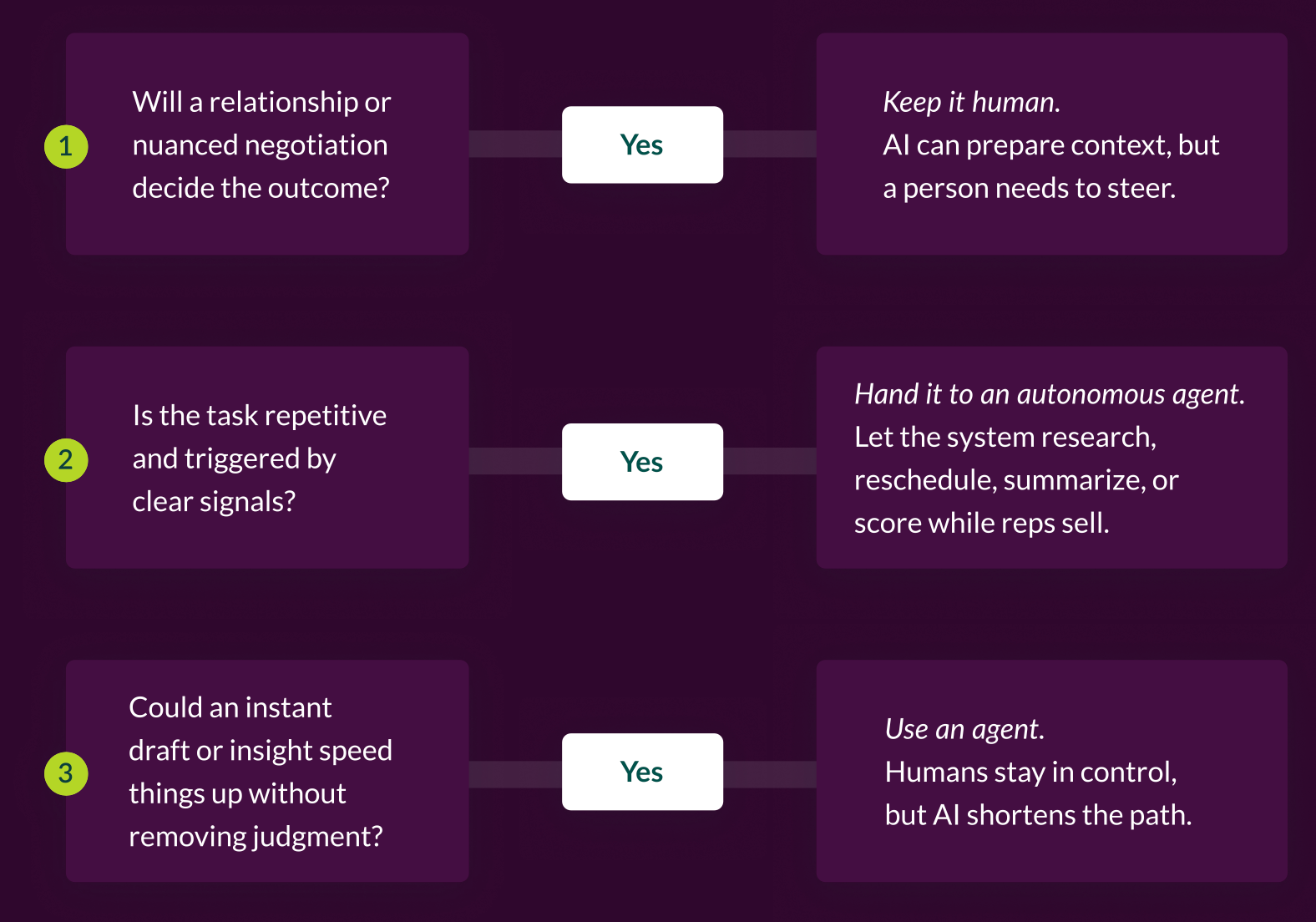
5 high-impact use cases to get immediate value from agents
Agentic AI is built to solve the specific execution gaps that hold back revenue performance. Since it’s connected to all your systems and knows every bit of context about your accounts, agentic AI can support activities for every role and every level of your revenue organization:
- Strategic decision making
Agents can summarize and interpret information, pulling analytics from dashboards to answer questions, identify trends, and provide recommendations tailored to users’ goals.
- Accelerated deal management
Sellers can close deals faster with the help of agentic AI to prioritize accounts for the highest opportunity or best engagement. Users can ask agents questions to get up-to-date account information.
- Customer growth opportunities
Agents can identify buying signals, cross-sell, upsell, and renewal opportunities, or risk of churn, then guide users to take action on opportunities and get ahead of risk.
- Coaching and performance
You and your managers can’t review every customer call, but AI agents can. Agentic AI can analyze calls and assist with scoring and recommendations to deliver feedback where it’s most relevant and focus coaching time.
- Context-aware prospecting
Agents can use relevant prospect insights, including buyer role and company information, to draft tailored messaging and adapt tone. Personalization becomes a default, not a detour.
Automate the busywork. Elevate the human work.
By offloading time-intensive tasks such as research, follow-up, admin, and summarization, sellers get more space to focus on what you hired them to do: build trust, advance conversations, and close deals.
The benefit is sharper judgment, better coaching, and more consistent execution across the team.
And when the AI is explainable, embedded, and aligned with existing behavior, trust follows. Adoption improves and performance compounds.
We designed agents to help humans do their best work, not just automate it.”
Look for these principles in agentic AI:
- Partners: AI agents built for revenue-specific workflows are ready to drive impact from day one, giving you faster time to value, whether taking over tasks or helping people work more effectively.
- Intelligence: Integrations harness the best, most relevant data across your tech ecosystem, then analyze and enrich your sellers’ workflows without requiring technical resources.
- Orchestration: Agentic workflows meet your revenue strategy, ensuring your system evolves with your business, not the other way around. Manage, monitor, govern, ensure security, track ROI, and even build custom agents tailored to your sales signals and processes.
- Explainability: Agentic AI shows its work, explaining its reasoning so you and your team can use it with confidence.
Teams that adopt agents don’t just get more efficient. They get more agile to unlock more opportunity and growth. That’s why agentic AI is a game-changer for adaptability, one of the top skill gaps identified in Salesloft’s 2025 Skills Gap Report.
The 3 critical pillars of enterprise-ready AI
While the pressure is on to move quickly with agentic AI, it’s essential to be strategic. Your choices now will shape how your organization grows, adapts, and scales its sales AI systems in the coming years.
Make sure your agentic AI is scalable by building partnerships and systems that will support the needs of the business in the long term.
Three pillars make the difference:
- Trusted data
Agents’ speed and efficiency depend on their access to comprehensive, up-to-date revenue data. Revenue tech stacks are complex, so you’ll need a system that can easily integrate with a variety of systems and reliably pull in accurate, high-quality data at scale. The platform should track every interaction across your sales cycle from Day 1 to ensure accurate, complete data.
- Governance and transparency
Partner with your CIO to build rules and visibility into your agents for increased trust and reduced risk. Create shared definitions, establish guardrails, and maintain open communication with the technical team to get off on the right foot.
- Workflow integration and orchestration
Standalone tools slow teams down. Embedded agents inside existing workflows will improve adoption and impact. Better yet, a platform allows you to orchestrate agents across workflows and teams, creating shared intelligence and breaking down silos while giving you the ability to customize agents for specific jobs.
Don’t squander your agents by isolating them
A single agent can solve for a specific use case. The power of agentic AI compounds when insights flow freely across connected systems, outcomes become trackable, and agents improve based on what’s working across the funnel.
This is where point solutions fall short. They automate one task in one moment for one rep. They don’t learn, share context, or ladder up to strategic goals.
But sales is no longer just about a buyer and a seller; it’s about a buying group and a selling or account team. Since the dynamics on both sides are constantly shifting, key information often slips through the cracks.
Platforms solve for this complexity with:
- Orchestration: Agents in a platform work together, sharing intelligence to align marketing, sales, and customer teams.
- Performance tracking: With outcomes tied to actions, you can optimize how agents behave, how sellers respond, and where to invest.
- Self-optimizing intelligence: As more data flows through the system, agents improve by refining recommendations and adapting to real behavior, not hypothetical use cases.
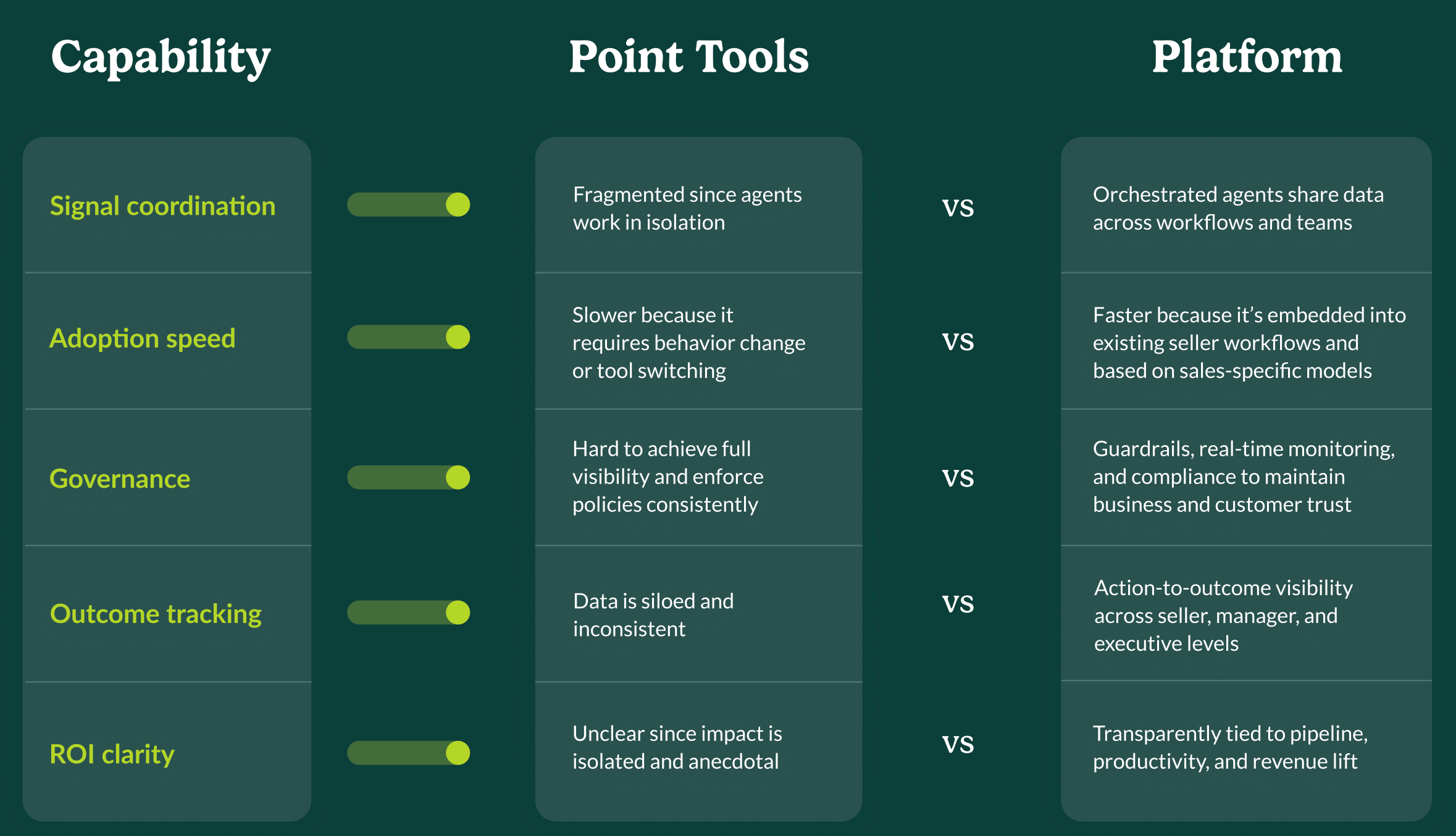
Activate agentic AI across your revenue team
Agentic AI isn’t a future-state concept. It’s a growth lever — one that improves how your team prioritizes, executes, coaches, and forecasts. And if you take the right approach, you can activate it without disruption, delay, or another disconnected tool in the stack. What you do next matters.
Here’s where to start:
- Align with your CIO and RevOps team: Governance and trust aren’t optional. They’re what make AI usable.
- Define your priority use cases: Focus on high-impact use cases aligned to your business goals, such as account prioritization, coaching, or deal acceleration, and start there.
- Evaluate platforms, not point tools: Look for orchestrated systems that connect insight to action, and action to outcomes.
- Ask the right questions:
- Does this AI surface explainable, behavior-aligned recommendations?
- Can we embed it into the team’s daily workflow without adding friction?
- Can these agents deliver value on Day One? Zero configuration gives you faster time to value.
AI unlocks speed so sellers can unlock revenue
Get a demo of Salesloft’s AI agents and learn how to activate agentic AI across your team without the implementation headache.
